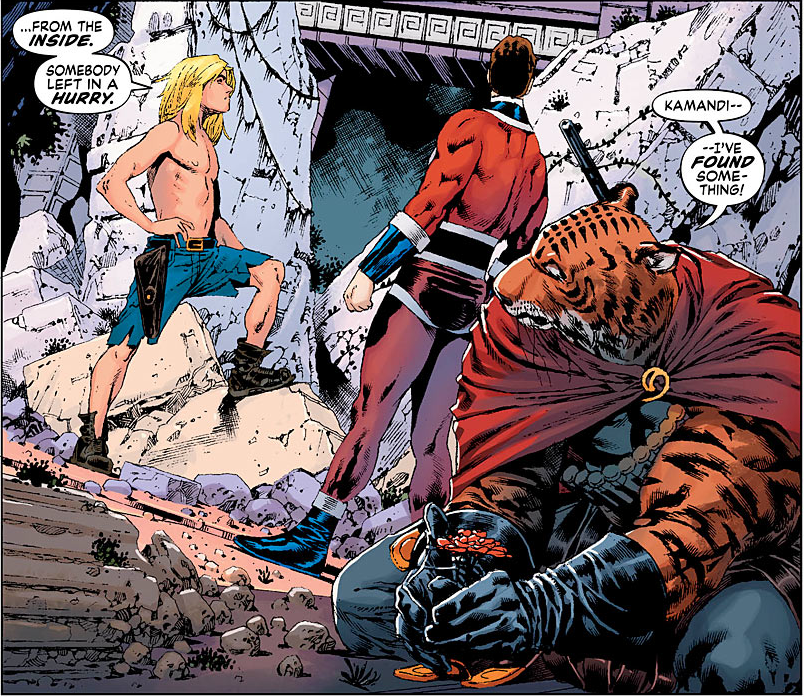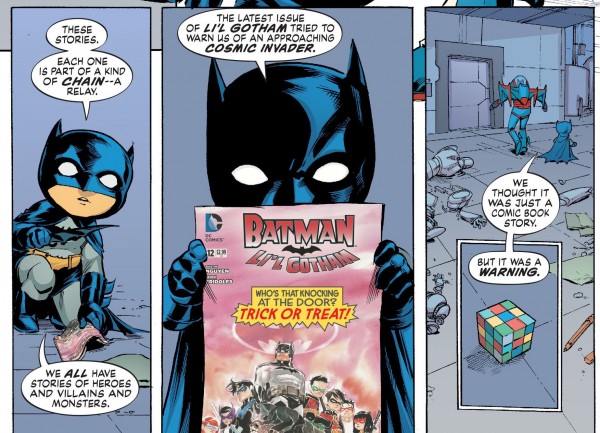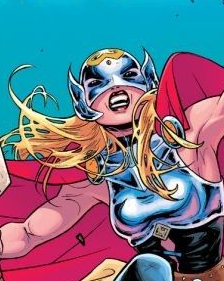Deadshirt Is Reading… is a weekly feature in which Deadshirt’s staff, contributing writers, and friends-of-the-site offer their thoughts on Big Two cape titles, creator-owned books, webcomics and more. For more of our thoughts on this week’s new comics, take a look at Wednesday’s Deadshirt Comics Shopping List.
Dom, Joe and Max are reading…
In this month’s Multiversity Roundtable, Deadshirters Dom Griffin, Max Robinson and Joe Stando fine-tuned their vibrational frequencies and shared their impressions of the installment out this week.
The Multiversity Guidebook #1
Written by Grant Morrison
Art by Marcus To (Batmen section) and Paulo Siquiera (Kamandi Section)
Colored by Dave McCaig (Batmen) and Hi-Fi (Kamandi)
Lettered by Todd Klein
Multiverse Illustrations by Declan Shalvey, Cameron Stewart, Darwyn Cooke, and more
DC Comics
“EMPTY IS THY HAND!”
I say this every time, but this week’s Multiversity may be my favorite. Far from being a simple backmatter book (although I love those too), it’s the first direct look at the overarching crisis that we’ve seen since the first issue, and it links the most distantly related book, Thunderworld, right into the action. The Cloud Atlas-like structure is a masterstroke, one which turns the guidebook itself into a key artifact in the conflict, continuing to draw the reader in on a metatextual level. In addition to the frame stories, there are plenty of clever and fun bits in the guide text itself, like the mystery worlds, and the barely-engaged tone of the entry on Earth-29. The selection of Earths that make up the new Multiverse is interesting too, with picks like Just Imagine Stan Lee Creating the DC Universe, Thrillkiller, and New Frontier side-by-side with ongoing books like Earth-2 and Multiversity-based Morrison worlds. I’m curious how many of these were editorially-mandated, and how many were Morrison’s own selections, for use later in the series. As “the guide to the DC Multiverse,” the book necessarily serves two masters, but it’s fitting that this sort of meta-story uses it to deepen and advance the story in addition to providing synopses.
– Joe Stando
Everyone and their mother (including David Uzumeri, listlessly in search of respite) presumed this week’s Multiversity Guidebook would be a simple encyclopedia, an invaluable DVD extra designed to enhance the regular reading experience. instead, Grant Morrison and an insane host of artists turn the “Who’s Who”/”A-Z” framework on a dime, incorporating two dueling back-up stories linked by the in-game field map that you the reader hold in your hands. If you’ve read Morrison’s cape comic textbook Supergods, this week’s Multiversity feels like the class project his first batch of students would make after studying that particular tome. I was most struck by how well it explained DC’s convoluted metanarrative up to now, intermingling legit publication history and kayfabe comics continuity in a way that almost makes it all feel planned, and not cascading happenstance reordered by a genius to imply a magical sort of fate. The notion that Earth-33 (our Earth) is inexorably tied to this living, breathing universe, and that whole realities are at the mercy of the ebbs and flows of the comic industry, is both haunting and kind of amazing.
Who knows? Maybe the Guidebook is right.
– Dominic Griffin
My visceral response to closing this week’s 80-page chunk of Multiversity was an audible “WOO!” Back-matter heavy one-shots like this often feel like a dumping ground for reprinted material and blocks of text lifted from the production process. But reading The Multiversity Guidebook, I was astonished by just how well crafted the end product was. While, yeah, a good portion of the book consists of largely enjoyable pin-ups/short text pieces about various alternate DC Earths (I want an ongoing series about the Sunshine Superman/Prez Earth btw), it’s held together by an ambitious and exciting narrative. When the Atomic Knights by way of Judge Dredd Batman shows up to save his chibi “Little League” counterpart from evil Sivana robots, you can feel the story beat explode off the page. If that were all, this would be a fun done-in-one team up story, but then you realize this plotline seamlessly connects to a parallel story featuring Kamandi and a host of other Jack Kirby creations investigating an all too familiar crypt. And then on top of that, Morrison flips a table over with a super creepy reveal about one of the alternate Batmen that throws everything we’ve just seen into a whole new light. The actual comic portions of this installment could’ve easily been fun throwaways from guest writers, but that they actively flesh out and progress the larger narrative of Multiversity is an unexpected but welcome surprise. If Pax Americana was a filet mignon and Thunderworld was a tasty chocolate chip cookie, The Multiversity Guidebook is the comics equivalent of obscenely good Chex Mix meant to tide us over between courses.
– Max Robinson
Joe Stando is reading…
Written by Jason Aaron
Art by Russell Dauterman
Colored by Matthew Wilson
Lettered by Joe Sabino
Marvel
“You are a blasphemy! There cannot be two Thors!”
The first arc of the new Thor series is wrapping up, and we’re hitting some of the final prerequisites of her origin: specifically, how the former Thor is going to take the news. Jason Aaron does a good job of writing the clash between the two gods of thunder that we all hoped for (or at least knew was coming) without throwing either of them under the bus. (Old) Thor is a character whose origin is defined by his arrogance and hot temper, and especially with the movies, that’s a personality trait everyone expects. (And Dautermann’s art has him looking even more like Hemsworth than usual in this issue.) But at the same time, the former god is mature and wise enough to know when he’s wrong and to stand aside, and it’s a relief he doesn’t seem set up to be bitter or sulky in his presumable future appearances.
As for the new Thor, we don’t get a ton more insight into who she is, but we do get confirmation of who she isn’t: Freyja, Thor’s mother. I’m sort of relieved about this, as I’d rather see Thor turn out to be a bit more of a wild card (my dream is Patsy Walker/Hellcat, but I’m a reasonable man). To be honest, I’d be fine if they did away with the mystery identity element entirely, so we could get more detail on this person’s transformation and acclimation to godhood. I’ve definitely enjoyed this arc, with its frost giants and minotaur CEOs, but I’m even more excited to see Thor begin to interact with the Marvel Universe at large, within the pages of Avengers and Spider-Man and Squirrel Girl. The table-setting is over, and I’m excited to see what Aaron, Dautermann and other creative teams have in store for Thor, Odinson, and everyone else.
Written by Becky Cloonan and Brenden Fletcher
Art by Karl Kerschl and Msassyk & Serge LaPointe (colors)
Lettered by Steve Wands
DC Comics
“I do have some experience playing a ghost, you know! Heh heh!”
Gotham Academy continues to be, quite simply, a delight. It’s been discussed a lot, especially given rumors of cancellation, but there’s really no other comic like it. It has much more in common with YA mystery novels or teen soaps than anything else DC is putting out right now, yet it still feels totally at home in the Batman family. This week featured yet another deep cut from Batman lore with the drama teacher, Simon Trent, who’s played a bit more like Vincent Price here. It was quick and fun, and emblematic of spirit of GA: it goes its own way, but it still benefits from the context of the Batman universe.
This week also featured an appearance by a more familiar character [SPOILERS FOLLOW]: the reveal that Killer Croc has escaped from Arkham and is living in the walls of the school. This could’ve been played like a jump scare or a cliffhanger, but its execution was something far more subtle and sad. In some of his best depictions, Croc is a brute, but a misunderstood one. There’s a sense that if he could just escape, both from cops and Batman pursuing him and from his own base impulses, he could find peace and happiness. Kerschl enhances this by using a character design similar to Batman: The Animated Series, which had some of the most sympathetic Croc stories. He looks tired here, and worn out. It’s a fantastic bit of characterization, done in a page and some change.
A complaint I’ve seen floated about Gotham Academy is that it’s confusing, or that people reading it feel like they’ve missed something. While that may be the case for them, I think it has more to do with how the book is paced versus most superhero books. Not every scene is going to be followed up on immediately, and not every big moment will explode into a couple splash pages. The story unfolds more gradually, with issues sometimes being more chapters than standalone stories. That might not be to everyone’s tastes, and that’s fine. But I love it, and I hope Cloonan, Fletcher, Kerschl and the rest of the creative team have a chance to reveal their vision a bit more.
[For more on Gotham Academy, peep our series overview from David Uzumeri!]
Thanks for reading about what we’re reading! We’ll be back next week with a slew of suggestions from across the comics spectrum. In the meantime, what are you reading? Tell us in the comments section, on Twitter or on our Facebook Page!





